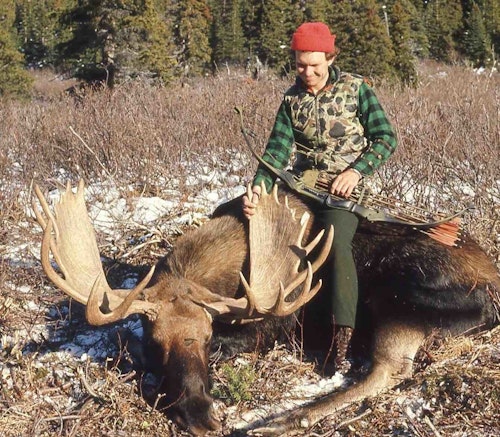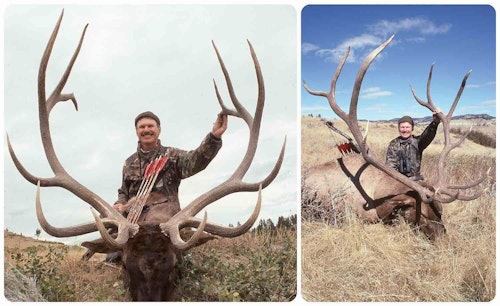
The author’s Mathews Triax measures 28 inches axle to axle and must be shot with a release, while his Hoyt LX Pro, which was discontinued long ago, is 47 inches and works well with fingers. In addition to the obvious difference in bow length, notice the size and shape of a modern cam vs. an energy wheel.
I get it — almost every new bowhunter who enters the ranks will shoot a compound bow that’s relatively short, somewhere between 28 and 33 inches axle to axle. Compounds of this length must be shot with a mechanical release because the string angle at full draw is too severe to use a finger tab.
Depending on draw length, a finger shooter could get by a 40-inch compound, and maybe even a 38-incher. About 20 years ago I did so with a Mathews Q2 XL (38 inches) and then a Mathews Icon (37 inches); my draw length is 27.5 inches.
I also shot two fabulous compounds designed specifically for finger shooters — a Reflex Caribou (45.75 inches) and a Hoyt LX Pro (47 inches); both bows were discontinued long ago. I gave away the Reflex Caribou to a relative who was getting into bowhunting, but I still own the Hoyt.

In addition to a longer length, a finger bow shoots best if the let-off is about 65 percent because more than that (like the 80-85 percent let-off so common today) makes it difficult to release the string well with fingers. As I recall, the Reflex Caribou and Hoyt LX Pro both had 65 percent let-off, in addition to old-school “energy wheels.”
If you look at compound bow offerings today, you can find a few 40-inch compounds, but these are high-dollar models designed for competition archery. A finger-shooter doesn’t need a bow with a MSRP of nearly $2,000, plus these compounds have fairly aggressive cams (compared to old-school energy wheels) and too much let-off to be comfortable for a finger release. These target bows are designed to be ultra-forgiving, provided you shoot them with a release.
I truly believe a manufacturer could sell a decent number of finger bows each year if they offered an affordable one with these simple specs: length of 45-47 inches, 65 percent let-off, energy wheels, and a reflex-style riser.
Traditional bow sales continue to be solid, and there’s no reason to think that some of the men and women who love the feel of a bowstring in their fingers wouldn’t enjoy shooting a long-axled compound, too.
Here’s the “chicken or the egg” question as it relates to compound shooters: Do 100 percent of new compound bowhunters shoot with a release because they WANT to, or do they HAVE to because 100 percent of today’s compounds require a release?
I’m hoping that with the recent news of Chuck Adams partnering with Bear Archery, the company will consider building a long-axled finger bow that he can use and promote. He was the first bowhunter to complete the Super Slam — killing one of every North American big game species recognized by Pope and Young — and he did it with finger bows (Hoyt and Reflex primarily). Adams took his first official P&Y record book animal, a Canada moose, in 1976 with a Bear Alaskan compound. It makes sense to me that Bear Archery would work with Adams on such a project; I hope it does to the decision-makers at Bear, too.

In my opinion, it’s time for an archery manufacturer to give compound users another choice. My wish for 2023 is for some company to step up and build a good-shooting finger bow priced at $549-ish. I think they’d be shocked with the sales numbers.

Chuck Adams photos from Chuck Adams Archery Facebook.





